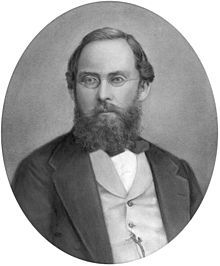August Heinrich Petermann
| August Heinrich Petermann | |
|---|---|
 |
|
| Born |
18 April 1822 Bleicherode, German Confederation |
| Died | 25 September 1878 (aged 56) Gotha, German Empire |
| Nationality | German |
| Fields | Cartography |
| Known for | "No issue without a map" |
Augustus Heinrich Petermann (18 April 1822 – 25 September 1878) was a German cartographer.
Petermann was born in Bleicherode, Germany. When he was 14 years old he started grammar school in the nearby town of Nordhausen. His mother wanted him to become a clergyman, but his excellence in the drawing of maps and his love for geographic readings made his choice of another career inevitable.
Heinrich Berghaus, with support of Alexander von Humboldt had started ‘Geographische Kunstschule’ (Geographica School of Art) in 1839 in Potsdam, close to Berlin, following the example of the school for engravers at the Archives Militaires Generales in Paris (since 1811). During its existence Berghaus’s academy offered only three courses, and only a few students attended:
Petermann’s father, August Rudolf Petermann, who was registrar at Bleicherode, could not pay for the further education of his son. When he read the advertisement for Berghaus’ school he send his son’s maps and other work for evaluation. One of the maps, drawn when he was 16, shows South America, and was later published in the journoal which was to carry his name. Berghaus must have recognized the quality of his work, and therewith his potential and soon took him in as a foster-son. As he had already a large family to feed, however, he requested an annual subsidy of 60 thaler from the king to support Petermann, which request was granted. During the 3rd course Berghaus treated his nephew Hermann Berghaus the same way. On Lange really paid for the courses, the rest following them at Berghaus’s own expense.
Petermann started in y.lpotsdam at 7 August 1839. The education with Berghaus could be called scientifically cartographic, comprising mathematical geography (map projection and grids), physical geography (meteorology, hydrology and geology) and political geography (knowledge of borders and administratpive division of European states especially). Physical training was more aimed at surveying, drafting and engraving. Berghaus’s pupils learned only the rudiments of surveying, even less than he himself had learned: their work in this area can be seen in the plan of Potsdam (Neüster Plan von der Königlichen Residenzstadt Potsdam / nach trigonometrischen Vermessungen, so wie geo- und hydrometrischen Aufnahmen ausgearbeitet in der Geographischen Kunstschule zu Potsdam unter der Leitung ihres Direktors, des Professors Dr. Heinrich Berghaus. 1845). They were not topographers and only used topography as published in the large-scale maps of that era as a general basis for their later, more generalized works. They were taught more to draft and engrave middle-scale geographic maps of states, continents etc., or their parts (e.g. the map of upper- and middle-Italy in 1847 for Stielers Handatlas, which was based on 's 1844 topographic map in nearly 100 sheets), small-scale generalized school maps, and especially applied geography and cartography as shown in their collaboration on the Physikalischer Atlas and the maritime atlas. During their study lithography, though not cutting as fine a portrayal as copper engraving, was on the rise because it was much cheaper. Though some experiments were made by Berghaus, e.g. for geological maps, by mixing copper engraving for the line- and other features and lithography for coloured polygons, there was no technology which could replace the exquisite expression copper engravings could reach. So the students mainly learned this art. Only at the end of his life Petermann became more enthusiastic for lithography, which had advanced by then. Up to and including the 10th edition of the Stieler Handatlas (1920–1925) the Perthes institute, where he worked from 1854 onwards, used copperplate engravings as the basis for its maps. All some 460 copperplates of this edition are currently preserved in the Perthes collections in Gotha.
...
Wikipedia
